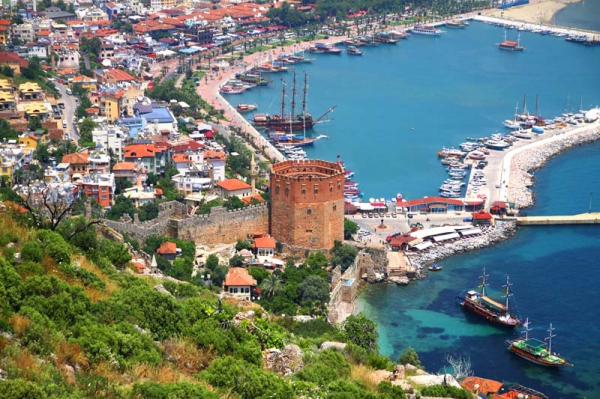The Antalya region stretches over about 400 km along the Mediterranean, parallel with the Taurus mountains

The Antalya region stretches over about 400 km along the Mediterranean, parallel with the Taurus mountains. It is a key province of Turkey, famous for its mild and pleasant climate, beaches, waterfalls, caves and historical places from all ages of history.
The region is a major tourist destination with 600000 beds (13 million visitors a year) and the most important location for congresses (200 a year) in Turkey after Istanbul.
Antalya city, founded in 150 B.C. by Attale II, king of Pergamum, is the fifth largest in the country and the metropolis houses over 2 million inhabitants.
Major sights
Clock Tower, Yivli (fluted) Minaret and numerous mosques in the Old Town (Kaleiçi), Hadrian’s Gate (he visited in 130 A.D.), Hidirlik Tower built in the second century A.D. as a lighthouse.
The Museum has one of the richest collections in the country, housing masterpieces from Hellenistic, Roman, Byzantine and Turkish periods. The most stunning is the huge number of monumental sarcophagi. Most pieces were gathered from antique cities in the area.
Going east, the lovely Düden waterfall with its surrounding park is an attraction not to be missed.
Perge
19 km from Antalya lies the antique city of Perge. Hittites settled in the area around 1500 B.C. but historians consider that it was founded at the end of the Trojan wars (1275 B.C). It is located on the road from Pergamum to Side. Alexander the Great took the city in 333 B.C. which fell later under the control of the kings of Pergamum before being turned over to Rome around 133 B.C. St Paul and his friends sailed from Paphos in Cyprus to Perge, beginning their religious campaign in 53 A.D.
Perge became the richest city in the Pamphylia region with its golden age in the second and third centuries A.D. (Hellenistic and Roman Empire periods). It is during the Roman period that today’s major monumental structures were erected : theatre, stadium, bath houses, fountains and agora.
Another golden era took place during the Christian period in the 5th and 6th centuries A.D.
In early times Perge was an important place of worship for the goddess Artemis, but it later became an important centre of Christianity, after Constantin the Great instituted that faith as the official religion of the Roman Empire in the first half of the 4th century A.D.
The Theatre could accommodate 12000 people and the U-shaped Stadium 27000. Access to the city is through a Roman and an Hellenistic gateways, with the Nympheum behind. A 9m wide Colonnaded Street once lined with shops and mosaics runs north to south, crossing another street near the Acropolis.
The Hellenistic city walls were defended by rectangular watch towers .
Other points of interest are the square Agora, Roman Bath Houses and the north and west Basilicas.
Aspendos
49 km east of Antalya, one reaches a Seljuk bridge crossing the Küprü river and the road continues to the ancient city built on a twin hill. It was occupied by inhabitants from the colony of Argos after the Trojan wars. Persians invaded many times and were defeated in 467 B.C. by the Greek commander Cimon, before returning in 425 B.C. and being vanquished by Alexander the Great in 334 B.C.
After Alexander’s death the city was controlled alternately by Ptolemies and Seleucids before falling under the domination of the Kingdom of Pergamum and later becoming part of the Roman Empire.
Most architectural remains date from the Golden Age of Aspendos in the second and third centuries A.D.
The Theatre, built during the reign of Marcus Aurelius (161-180 A.D.) by the architect Zenon and seating 10-12000 is the best preserved of its kind in the world. The 3-story stage building is 24m high and the roof was supported by 2 rows of 20 columns. The orchestra of over a half-circle could accomodate 500 and the seating area has 20 rows in the lower part and 19 in the upper one.
Access to the city is through three gates (South, East and North). Water was brought from the mountains to the city via a 1 km-long aquaduct on 15m-high arches built in the middle of the 2nd century A.D.
Main other points of interest : the Colonnaded Street, the Agora, Baths from several periods, Nympheum , Library, remains of Temples of Athena, Apollo, Dionysus and Men (Anatolian Moon God). Climbing along a steep footpath, one reaches the top of the acropolis affording a panoramic view of the theatre with the Basilica in the background.
Side
Built on a small peninsula extending north to south into the sea, the city, largest port of ancient Pamphylia, lies 72 km east of Antalya ; its name means « pomegranate », symbol of fertility. Its colonization by settlers from Kyme/Aeolia occurred in the 7th century B.C. It fell under the domination of Persians in the 5th century B.C., surrendered to Alexander the Great in 333 B.C. and became part of Pamphylia under the Roman Empire in 129 B.C.
In the 5th and 6th centuries A.D. it was the seat of the Bishopric of Eastern Pamphylia.
30km-long aquaducts brought water to the city, feeding the monumental fountain of the Nympheum across from the Main Gate outside the town walls, with the South Gate to the east. Two main Colonnaded Streets run in opposite directions. The Agora lies below the Theatre built in the 2nd century A.D. with a seating capacity of 15000 with 29 rows in the lower section and 24 in the upper one. Next to the theatre there is a huge Arched Door from the Roman period with the Fountain of Vespasian next to it. The rectangular Temple of Athena is on the way to the sea with six Corinthian columns on the short sides and 11 on the long ones. Next to it stands the Temple of Apollo with some restored creamy-white columns striking a sharp contrast against the sea. A 2nd century A.D. former Roman Bath House has been turned into the most interesting Side Museum housing a rich collection of all finds discovered in the town.
The charming modern town, with its seaside promenade lined with terraced restaurants and its numerous pedestrian streets lined with shops, is a delight for strollers and shoppers alike.
Jacques J. Campé





